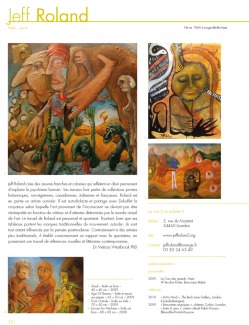"Wabbits and Eggmen" shown at The Museum of Everything Exhibition 2 at the Tate Modern !!! - and now part of the Museum collection.
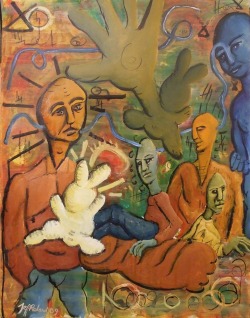
For the tenth anniversary of the Tate Modern, Art places have been invited to invest the Hall and show works, it was the occasion for the Museum of Evrything to launch its exhibition 2, while the first one has gone to Torino !!!
My work was chosen by a panel of judges to be part of the show and i am very happy about this , as they are one of the liveliest crew i know of !!!
"Wabbits and Eggmen" is now part of the Museum of Everything collection !!
My work was chosen by a panel of judges to be part of the show and i am very happy about this , as they are one of the liveliest crew i know of !!!
"Wabbits and Eggmen" is now part of the Museum of Everything collection !!
Three new works of mine enter the Davis Museum in Barcelona !!

Check out their site www.davismuseum.com
Michael K. Corbin , the famous Artbookguy , interviews Jeff Roland on his website
ArtBookGuy.com
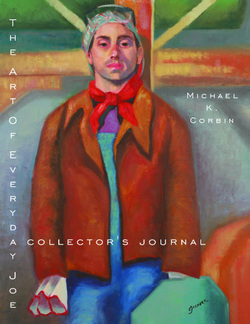
You absolutely need to check out the artbookguy.com website, read the insightful articles, interviews, and more .
In the meantime, here is the interview, as found on the artbookguy's site
JEFF ROLAND
Jeff Roland is an artist of French descent who currently lives with his family in Eulmont, Lorraine, France. I think we met online www.jeffroland.org. He creates these very intriguing paintings depicting human-like figures in interesting settings. In short, Roland likes playing with ideas of individuality and differences. I think he's a talented artist who tells a story with every painting. Read on and find out more about Jeff.
MICHAEL: Hey Jeff. To me, your work is really "old school" in the sense that your paintings are strongly narrative. There always seems to be a story even though we may not be able to figure out the story. Do you see yourself as a storyteller in addition to a painter?
JEFF: Well Michael, I am definitely an "old school" painter ... or maybe I'm re-introducing a part that was missing as I'm also fully aware of the arguments of the post-modern artists, which would possibly put me into the post-post modernism era or something like that. I am a storyteller and have always been inside and outside a painting. Telling stories or proposing tales is to me a way to see whether the images I put forward have an effect on the spectator. And then, to see whether it matches my expectations, which makes it even more old school as I do have expectations as far as the viewer is concerned. In fact, he or she is a partner or a co-player to the game.
MICHAEL: I've never heard an artist put it quite that way. That's very cool. With that in mind, how do you create a painting?
JEFF: I usually observe a simple situation in reality and let this situation derive into a reflection and consider the implications at a broader level, sociological, political, psychological and philosophical. And in this way, as I paint, the story unfolds in front of my eyes and I invite the spectator to participate. For example, in my paintings entitled Statues, I present two figures that are rushing or seem to pass by without noticing other. They are the ones who lead their lives without taking too much notice of others. They are into a project or to put it simply, know where they are going. Then there are two other figures represented as trees, living trees, with long roots. They have chosen to lead a static life. They have made another choice based on roots, family, something around them. They are fully happy with that, both groups have made choices and live accordingly. Then, you can see two characters, looking at both other groups. They are the ones who spend their time criticizing, patronizing and observing with bitterness and disgust at the others.
MICHAEL: Very interesting scenarios from real life.
JEFF: This is a situation of everyday ... some people are like that. But it's true that when you look at the painting, it can be seen from another angle. This is very welcome and I'm always very interested to hear different interpretations, but I have my story. It is always important for me that the painting may be a simple aesthetic pleasure for the viewer. He or she doesn't have to understand. People should be free and I know that that aspect of respecting the need for the pleasure of the eyes and nothing else is another very old fashioned trait and I have no problem with that at all.
MICHAEL: The figures in your work seem to be humanistic rather that fully human. To me, they seem to be otherworldly caricatures.
JEFF: Yes or sometimes not even humanistic at all which makes me step away from the old school unless you go back in time enough to see that representations of figures, be they human, gods, goddesses or otherworld creatures, are in fact coming straight from a zone in our mind where nothing is really clear. I have occasionally worked on figurative human forms, for example, when someone wants me to draw or paint a portrait. Well, I will do it, but I won't be able to refrain from bringing a scene or character or shape that will step apart from realism. I admire the best works of figurative painting, but what truly attracts me is the spiritual value of paintings.
MICHAEL: How do you show that?
JEFF: This can be expressed through several different aspects: color, shapes, representations, musicality, atmosphere, you name it. I believe that the sincerity in your process and the dedication to your "ritual" as a painter are most important. I feel related to the early primitives, to whom all sorts of representations and inventions are possible. Not real, but possible.
MICHAEL: And that speaks to the "otherworldliness" of your figures.
JEFF: Other worlds are the worlds around us and we are others too if seen through the right eyes. The idea of difference, acceptance of it and dealing with it is central to my painting, which has been tagged as outsider before, but is rather more precisely the expression of "outsiderness." It's through an ensemble of various processes, most of which are invented on the spot, which makes me also understand that I still have to discover what my work will be made of in the future. I want to try to be open to experience, textures, paint, techniques, inventing or re-inventing techniques, learning and un-learning to paint, structuring and destructuring. I can't remember exactly a quote by Antoni Tapiès, but he said something like ... "An artist can only be considered as such when he's undertaking an adventure." I can refer to this quite perfectly, allowing myself and my spectators to live an adventure!
MICHAEL: You just said your art is often about the "idea of difference" or "outsiderness." My guess is that you've experienced this in your own life and perhaps that's why it's such a strong theme in your work?
JEFF: First of all, I don't come from an artistic family or surroundings. This has always given me a feeling of having to give long explanations about how I see the world, how come I wasn't interested in very down to earth thoughts and the like. At a point, I really felt like an outsider because, I just felt un-adapted or literally somewhere else. I have drawn as far back as I can remember. It was not a way out, but a sort of meditation. I have gotten into a habit of reaching for another world inside my mind, creative, fun, intellectual, playful and developing imagination without having to rely on my surroundings.
MICHAEL: Believe me, as a writer, I can totally relate.
JEFF: I was a quiet kid, pondering a lot. But even if quiet, I was attracted to the people who were the most different from me ... different cultures, social backgrounds, ways of life. Then I started learning English and went to England every year during the summer to take in the culture and see France from another point of view. I don't know whether you have noticed but there's something weird about France. It seems to pretend that we all live as a group sharing a lot and not having the need for communities. I reckon this is a mistake and this process of restraining people affected my work a lot.
MICHAEL: The French do seem very independent spirited to me.
JEFF: Well, as for my life, I do feel a little like Groucho Marx when he says that he wouldn't want to belong to a club that would accept him as a member. I don't want to belong. I want to be free, I want others to be free. Mind you, I do believe in rules, but most of the ones I follow are self evident, not mass control. This is another theme in my work that's linked to the previous one ... control. For the sake of our own biodiversity, not just strange animals in a rainforest, but us, as thinking apes, it is important to open our eyes and ears and not let anybody control us and make us forget about our differences. Difference is wealth, progress and fun.
MICHAEL: Oh, I like that observation!
JEFF: Uniformity is always uniform according to the choices of somebody and that somebody obviously isn't you. But maybe you're asleep!
MICHAEL: Amen Brother! Thanks Jeff. I really love your work and this has been great.
To see Jeff Roland's cool and imaginative works, check out his website at www.jeffroland.org.
In the meantime, here is the interview, as found on the artbookguy's site
JEFF ROLAND
Jeff Roland is an artist of French descent who currently lives with his family in Eulmont, Lorraine, France. I think we met online www.jeffroland.org. He creates these very intriguing paintings depicting human-like figures in interesting settings. In short, Roland likes playing with ideas of individuality and differences. I think he's a talented artist who tells a story with every painting. Read on and find out more about Jeff.
MICHAEL: Hey Jeff. To me, your work is really "old school" in the sense that your paintings are strongly narrative. There always seems to be a story even though we may not be able to figure out the story. Do you see yourself as a storyteller in addition to a painter?
JEFF: Well Michael, I am definitely an "old school" painter ... or maybe I'm re-introducing a part that was missing as I'm also fully aware of the arguments of the post-modern artists, which would possibly put me into the post-post modernism era or something like that. I am a storyteller and have always been inside and outside a painting. Telling stories or proposing tales is to me a way to see whether the images I put forward have an effect on the spectator. And then, to see whether it matches my expectations, which makes it even more old school as I do have expectations as far as the viewer is concerned. In fact, he or she is a partner or a co-player to the game.
MICHAEL: I've never heard an artist put it quite that way. That's very cool. With that in mind, how do you create a painting?
JEFF: I usually observe a simple situation in reality and let this situation derive into a reflection and consider the implications at a broader level, sociological, political, psychological and philosophical. And in this way, as I paint, the story unfolds in front of my eyes and I invite the spectator to participate. For example, in my paintings entitled Statues, I present two figures that are rushing or seem to pass by without noticing other. They are the ones who lead their lives without taking too much notice of others. They are into a project or to put it simply, know where they are going. Then there are two other figures represented as trees, living trees, with long roots. They have chosen to lead a static life. They have made another choice based on roots, family, something around them. They are fully happy with that, both groups have made choices and live accordingly. Then, you can see two characters, looking at both other groups. They are the ones who spend their time criticizing, patronizing and observing with bitterness and disgust at the others.
MICHAEL: Very interesting scenarios from real life.
JEFF: This is a situation of everyday ... some people are like that. But it's true that when you look at the painting, it can be seen from another angle. This is very welcome and I'm always very interested to hear different interpretations, but I have my story. It is always important for me that the painting may be a simple aesthetic pleasure for the viewer. He or she doesn't have to understand. People should be free and I know that that aspect of respecting the need for the pleasure of the eyes and nothing else is another very old fashioned trait and I have no problem with that at all.
MICHAEL: The figures in your work seem to be humanistic rather that fully human. To me, they seem to be otherworldly caricatures.
JEFF: Yes or sometimes not even humanistic at all which makes me step away from the old school unless you go back in time enough to see that representations of figures, be they human, gods, goddesses or otherworld creatures, are in fact coming straight from a zone in our mind where nothing is really clear. I have occasionally worked on figurative human forms, for example, when someone wants me to draw or paint a portrait. Well, I will do it, but I won't be able to refrain from bringing a scene or character or shape that will step apart from realism. I admire the best works of figurative painting, but what truly attracts me is the spiritual value of paintings.
MICHAEL: How do you show that?
JEFF: This can be expressed through several different aspects: color, shapes, representations, musicality, atmosphere, you name it. I believe that the sincerity in your process and the dedication to your "ritual" as a painter are most important. I feel related to the early primitives, to whom all sorts of representations and inventions are possible. Not real, but possible.
MICHAEL: And that speaks to the "otherworldliness" of your figures.
JEFF: Other worlds are the worlds around us and we are others too if seen through the right eyes. The idea of difference, acceptance of it and dealing with it is central to my painting, which has been tagged as outsider before, but is rather more precisely the expression of "outsiderness." It's through an ensemble of various processes, most of which are invented on the spot, which makes me also understand that I still have to discover what my work will be made of in the future. I want to try to be open to experience, textures, paint, techniques, inventing or re-inventing techniques, learning and un-learning to paint, structuring and destructuring. I can't remember exactly a quote by Antoni Tapiès, but he said something like ... "An artist can only be considered as such when he's undertaking an adventure." I can refer to this quite perfectly, allowing myself and my spectators to live an adventure!
MICHAEL: You just said your art is often about the "idea of difference" or "outsiderness." My guess is that you've experienced this in your own life and perhaps that's why it's such a strong theme in your work?
JEFF: First of all, I don't come from an artistic family or surroundings. This has always given me a feeling of having to give long explanations about how I see the world, how come I wasn't interested in very down to earth thoughts and the like. At a point, I really felt like an outsider because, I just felt un-adapted or literally somewhere else. I have drawn as far back as I can remember. It was not a way out, but a sort of meditation. I have gotten into a habit of reaching for another world inside my mind, creative, fun, intellectual, playful and developing imagination without having to rely on my surroundings.
MICHAEL: Believe me, as a writer, I can totally relate.
JEFF: I was a quiet kid, pondering a lot. But even if quiet, I was attracted to the people who were the most different from me ... different cultures, social backgrounds, ways of life. Then I started learning English and went to England every year during the summer to take in the culture and see France from another point of view. I don't know whether you have noticed but there's something weird about France. It seems to pretend that we all live as a group sharing a lot and not having the need for communities. I reckon this is a mistake and this process of restraining people affected my work a lot.
MICHAEL: The French do seem very independent spirited to me.
JEFF: Well, as for my life, I do feel a little like Groucho Marx when he says that he wouldn't want to belong to a club that would accept him as a member. I don't want to belong. I want to be free, I want others to be free. Mind you, I do believe in rules, but most of the ones I follow are self evident, not mass control. This is another theme in my work that's linked to the previous one ... control. For the sake of our own biodiversity, not just strange animals in a rainforest, but us, as thinking apes, it is important to open our eyes and ears and not let anybody control us and make us forget about our differences. Difference is wealth, progress and fun.
MICHAEL: Oh, I like that observation!
JEFF: Uniformity is always uniform according to the choices of somebody and that somebody obviously isn't you. But maybe you're asleep!
MICHAEL: Amen Brother! Thanks Jeff. I really love your work and this has been great.
To see Jeff Roland's cool and imaginative works, check out his website at www.jeffroland.org.
Invited to take part and be featured in the Visionary Art Yearbook
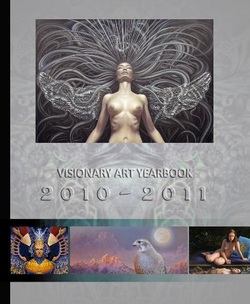
In January 2009, Otto Rapp started a Private Network of Visionary
Artists on the Ning Platform with a handful of friends. Since then, the
Membership has steadily grown and includes some of the very best
Visionary Artists in the Universe.
Many of these artists had been friends for decades, others are new to the fold. This Yearbook is a celebration of the cooperative spirit of these Artists and their accomplishments.
Mr Otto Rapp made me the honour of including me in the book !! YOU MAY ORDER IT HERE
Many of these artists had been friends for decades, others are new to the fold. This Yearbook is a celebration of the cooperative spirit of these Artists and their accomplishments.
Mr Otto Rapp made me the honour of including me in the book !! YOU MAY ORDER IT HERE
Three works of mine featured in the Royal College of London Psychiatrists Newsletter Read it here !
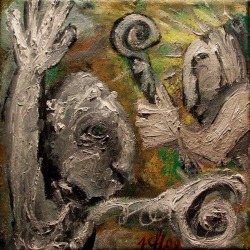
Three pieces of my work featured in the Royal College of Psychiatrists London Division Newsletter , together with brilliant analyses of my work by Dr Melissa Westbrook !!
I am very happy to be part of this publication and want to thank all the editorial team !
I am very happy to be part of this publication and want to thank all the editorial team !
| London Psychiatrists Newsletter June 2010 | |
| File Size: | 774 kb |
| File Type: | |
Jeff Roland - featured artist of the month on the World Artist Network

Jeff Roland's page in "La Bible de l'Art Singulier"
Introduction to the Brick Lane Gallery Exhibition Catalogue ,
by Dr Melissa Westbrook, PhD
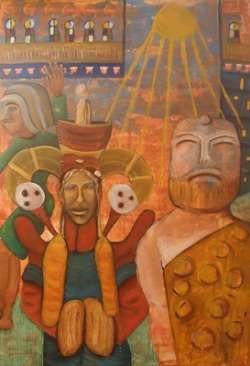
Jeff Roland creates bold, vibrant pieces which reflect a constant desire to explore the human psyche. I Remember I Thought We Were Immortals (2009), All Kings Must Pass (2009) and L'Enlévement De Sabine (2009) highlight the complex symbolism which characterises his works. I Remember I Thought We Were Immortals, for example, explores the nature of conflict, its resolution and its function in collective memory. L'Enlévement De Sabine, a contemporary interpretation of the rape of the Sabine women, examines a similar theme. This painting, depicted in a raw style, captures the consumption of one culture by another. All Kings Must Pass reflects Roland's interest in anthropology. It records the decline of great historical societies and emphasises the precarious foundations that sophisticated civilizations are built on.
Distinctive, aquiline-nosed figures populate the foreground of Jeff Roland's work. Depicted in various styles - ranging from smooth and flat to heavily textured - they are used to make reference to numerous disparate artistic sources, including primitive art, Hieronymous Bosch, Paul Klee and Antoni Tapiès. Communicate (2009), for example, highlights Roland's interest in raw, outsider art and Jean Dubuffet. Seven Sinners (2009) reveals the influence of post modern interpolation. Here tribal-style figures are used as a contemporary cultural reference to the 1940s film of the same name starring Marlene Dietrich.
Born in 1969, Jeff Roland has sold works to collectors in France, the UK, the USA, Norway, Canada and Italy. His works have been shown at La Cour des Grands (Metz, 2009), Chateau Corbin (Liverdun, 2009) and the Centre des Arts Pablo Picasso (Blenod les PAM, 2009). Jeff Roland's 2010 schedule will include exhibitions in Rome and Norway.
(2010) © Dr Melissa Westbrook PhD
Distinctive, aquiline-nosed figures populate the foreground of Jeff Roland's work. Depicted in various styles - ranging from smooth and flat to heavily textured - they are used to make reference to numerous disparate artistic sources, including primitive art, Hieronymous Bosch, Paul Klee and Antoni Tapiès. Communicate (2009), for example, highlights Roland's interest in raw, outsider art and Jean Dubuffet. Seven Sinners (2009) reveals the influence of post modern interpolation. Here tribal-style figures are used as a contemporary cultural reference to the 1940s film of the same name starring Marlene Dietrich.
Born in 1969, Jeff Roland has sold works to collectors in France, the UK, the USA, Norway, Canada and Italy. His works have been shown at La Cour des Grands (Metz, 2009), Chateau Corbin (Liverdun, 2009) and the Centre des Arts Pablo Picasso (Blenod les PAM, 2009). Jeff Roland's 2010 schedule will include exhibitions in Rome and Norway.
(2010) © Dr Melissa Westbrook PhD
The Watchers and Chinese Beach : two works analysed by Dr Melissa Westbrook, PhD
The Watchers, oil on canvas, 2009
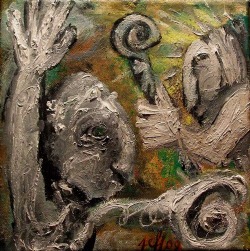
The Watchers forms part of a series of paintings which explore symbolic guardians and their function in contemporary society. In this piece Jeff Roland depicts two gargoyle-like figures in thick, loose brushstrokes reminiscent of Andre Masson. The guardian in the foreground dominates the canvas. With a raised arm it stares at its viewer blocking any attempt to engage with the space beyond. The scornful creature in the right mid-ground reinforces this sentiment.
Through these figures The Watchers inverts the traditional artistic relationship between viewer and object. The viewer becomes the viewed as the guardians seize control of the encounter. It is only through them that we able to gain insight into the work as they determine the information being disseminated. The guardian’s actions are post-post modern. They reassert an artist’s right to determine a piece’s meaning.
The space around the guardians only provides hints at the world beyond. Using Rousseau as his inspiration, the artist places a loosely painted jungle around them. It is not clear whether the figures in The Watchers are guarding an archetypal truth or the entrance to utopia. Instead, Roland plays with his audience. The blurred landscape could be a mirage. In this reading the gargoyles are not bastions of knowledge, as traditionally defined, but guardians of illusion and nothingness.
Through these figures The Watchers inverts the traditional artistic relationship between viewer and object. The viewer becomes the viewed as the guardians seize control of the encounter. It is only through them that we able to gain insight into the work as they determine the information being disseminated. The guardian’s actions are post-post modern. They reassert an artist’s right to determine a piece’s meaning.
The space around the guardians only provides hints at the world beyond. Using Rousseau as his inspiration, the artist places a loosely painted jungle around them. It is not clear whether the figures in The Watchers are guarding an archetypal truth or the entrance to utopia. Instead, Roland plays with his audience. The blurred landscape could be a mirage. In this reading the gargoyles are not bastions of knowledge, as traditionally defined, but guardians of illusion and nothingness.
Chinese Beach , mixed media on paper , 2009
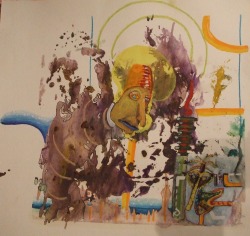
Inspired by the works of Jerzy Ruszczynski, Chinese Beach examines the universal themes of creation, gene manipulation and the destruction of the global ecosphere. It presents a clash between organic human development and the hideous gene mutants created through the rationale of science. A divine form, shown through a prehistoric symbol, watches the journey from single entity to enlightened being.
Organic evolution, from primitive to enlightened being, is symbolized by the primitive masks on the right side of the canvas. Indicative of the artist’s interest in anthropology, the masks appear in harmony with the ocean and vegetation that surrounds them. The hovering gold/blue face in the sky above signifies transformation from the physical to the spirit.
The development fostered by science presents a stark contrast with this pure form of evolution. Roland’s bunsen burner and test tube, rendered in opaque, thick colour, reveal the tools used to by the modern age to explore the mysteries of evolution. They enable man to fulfill his desire not only to create but also to modify his own image.
The large mutant figure which dominates the centre of the canvas is the product of these experiments. The creature’s face is typical of Roland’s characters, elongated face, long aquiline nose. His cocooned body and halo makes it clear that he is in the process of physical and spiritual metamorphosis. Yet unlike his primitive counterparts, the mutant’s body oozes toxic waste, shown through large splatters of colour, into the sea.
Chinese Beach does not extol the primitive life over one governed by science. It asks its audience to assess the impact of experimentation on the environment. On a deeper level Roland questions whether it is necessary to create modern Frankensteins in order to evolve.
An analysis of Jeff Roland's work by Manolo Ferreras, Spanish journalist
ROLAND, JEFF
(M. Ferreras) Symbolism full of signs, through "private universes" of primarily Transvanguard inspiration ... Born in Longeville-les-Metz (France), and today a resident of the City of Liverdun (with its castle and aspect of the Loire river valley), with expos in France, Rome, Britain ..., has a very personal imagery of magical surrealism, with hints of ethnic spirituality, primitivism, and so unique ...!: Mixed Stroke-traits for magical expression, from lyrical abstraction to "Brut" coloring, with oniric inspirations, fantastic, sometimes medieval (Romanesque ... brought to the century!), and in which case are distorted icons in the current era: streets, types, muralist, drama ... in a performance overflowing with nostalgia in search of hidden pictorial meaning, interlaced with postmodernism ... "and that leads him to his special" distortion "of the universe ... More, He has chosen muses, the most important ones being the Russian model Irina, and an American photographer named Elizabeth who are reinterpreted in an inspired way, repeatedly.
Original text in Spanish
ROLAND, JEFF
(M. Ferreras) Simbolismo pleno de signos, a través de “universos particulares” donde prima la transvanguardia del “10”… Nacido en Longeville-les-Metz (France), y hoy habitante de la Ville de Liverdun (con su castillo y aspecto de villa del Loira), con expos en Francia, Roma…, posee un imaginario tremendamente personal, de surrealismo mágico, con rasgos de espiritualidad étnica, primitivista, … ¡y tan singular!: Técnicas mixtas para trazos-rasgos de expresionismo mágico, de abstracción lírica hasta rayar en un “Brut” colorista, de postulaciones/inspiraciones oníricas, fantásticas, en ocasiones medievales (¡románicas... traídas al XXI!), y en cualquier caso iconos deformes de la era actual: calles, tipos, muralidad, dramatismo…, en una representación desbordada de “nostalgia en pro de la búsqueda del significado pictórico oculto, entrelazado a la postmodernidad…”, y que le conduce a su especial “deformación” del universo… Además, ha convertido en sus musas a la modelo jefa de su galería, Irina, y a una fotógrafa americana de nombre Elizabeth Thorp a las que reinterpreta, inspirado, de forma reiterada".
(M. Ferreras) Simbolismo pleno de signos, a través de “universos particulares” donde prima la transvanguardia del “10”… Nacido en Longeville-les-Metz (France), y hoy habitante de la Ville de Liverdun (con su castillo y aspecto de villa del Loira), con expos en Francia, Roma…, posee un imaginario tremendamente personal, de surrealismo mágico, con rasgos de espiritualidad étnica, primitivista, … ¡y tan singular!: Técnicas mixtas para trazos-rasgos de expresionismo mágico, de abstracción lírica hasta rayar en un “Brut” colorista, de postulaciones/inspiraciones oníricas, fantásticas, en ocasiones medievales (¡románicas... traídas al XXI!), y en cualquier caso iconos deformes de la era actual: calles, tipos, muralidad, dramatismo…, en una representación desbordada de “nostalgia en pro de la búsqueda del significado pictórico oculto, entrelazado a la postmodernidad…”, y que le conduce a su especial “deformación” del universo… Además, ha convertido en sus musas a la modelo jefa de su galería, Irina, y a una fotógrafa americana de nombre Elizabeth Thorp a las que reinterpreta, inspirado, de forma reiterada".
Est Republicain - Sept 2009 (French Newspaper)
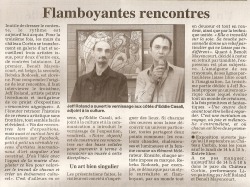
ENGLISH VERSION :
Flamboyant Encounters
No need to explain the context,as a pace has been found with the exhibitions. For the third time, Chateau Corbin has
changed into an art gallery, and welcomes three artists, among which two foreigners : The first one, Benoit
Mayencourt, is from Belgium, and Rebeka Rodosek is from Slovenia. To understand how they met, you need to
interview the third artist, Jeff Roland, a painter from Liverdun who initiated this exhibition project entitled "Unexpected Encounters".
Listening to him tell about the creation of this artistic network, all seems easy and obvious
: " Through different reunions during exhibitions, but also via chats on Facebook, gradually, a real network of
international outsider artists was created. From there came the idea to use this place, with the help of the city council,
in order to put forward everyone's work and create a cultural event ".This thus how Eddie Casali, deputy mayor
in charge of culture and communication introduced the opening speech of the exhibition, on Friday. " Our objective
is to give these encounters a solid basis to make it possible eventually to create a museum dedicated to this discipline"
Unexpected Art
After the introductions, the visitor is invited to feel the atmosphere of the place. Each piece makes us enter a
specific universe, they have two points of similarity : warm and luminous colours, and the woman as a federating
element. Then, each artist imposes his touch. For instance, Rebeka Rodosek has her flamboyant surreal style depicting
a soft and curvy world, as well as a specific technique " She's been working on silk.Her personal touch give a
particular depth which attracts your attention". As for Benoit Mayencourt, decided to remain discreet because of his
shyness, his expression is more subjective. The core of his pencil sketches, of his particular lines lets our imagination
wander. The third part, dedicated to Jeff Roland 's work, invites us into an oniric universe, in which live an ensemble
of creatures, both primitive and fantastic. " A work must first be a pleasure for the eyes. It's an invitation on a trip, in
which joy and blues intermingle, where everyone is invited to wander"
Exhibition open everyday except Mondays, up to the 10th of September at Chateau Corbin, from 2pm to 6pm, free
admission.
Don't miss today : from two to Six pm in the park of Chateau Corbin, live painting performance by Jeff Roland
and Benoit Mayencourt.
